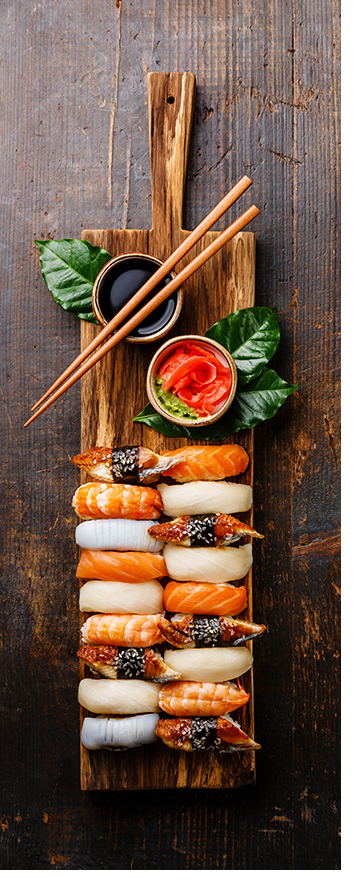 미국에 4만 5000개가 넘는 중식당이 있다는 것을 알고 있는가? 이는 맥도날드나 버거킹을 합친 것보다 많은 숫자다. 가장 놀라운 것은, 이 중식당의 소유주가 대부분 전 세계 두 지역 출신이라는 것이다. 바로 중국의 푸저우(푸젠 지역)와 타이산(광동 지역)이다. 중국 가족 관계망은 그들이 미국으로 이민한 후, 그들의 사업을 보조할 친척을 계속 불러들이며 더욱 강해졌다. 미국의 어느 마을에나 중식당이 자리하게 된 건 거의 100년이 넘었다. 비록 이 식당들의 음식이 진정한 중국식은 아니었을지 몰라도, 미국인 입맛에는 잘 맞았다. 미국 가족들은 외식할 때 중식당을 선호하기도 한다. 사실 미국 내 4만 5000개 중식당의 메뉴는 거의 똑같다. 미국에서 자신의 중식당을 오픈하고자 하는 이민자들에게 재료와 서비스를 공급하는 컨설턴트와 벤더는 규모가 매우 커서 이민자들이 비슷한 컨설팅을 받기 때문이다. 대다수의 이민자는 아주 기초적인 요리 기술만 가지고 있고, 따라서 그들이 전에 성공한 사람의 방법을 따르고자 하는 건 당연하다. 또한 미국에서 중국 음식은 영어를 전혀 하지 못하는 사람들이 만드는 비위생적이고 매우 저렴한 요리라는 악평을 듣기도 한다.
미국에 4만 5000개가 넘는 중식당이 있다는 것을 알고 있는가? 이는 맥도날드나 버거킹을 합친 것보다 많은 숫자다. 가장 놀라운 것은, 이 중식당의 소유주가 대부분 전 세계 두 지역 출신이라는 것이다. 바로 중국의 푸저우(푸젠 지역)와 타이산(광동 지역)이다. 중국 가족 관계망은 그들이 미국으로 이민한 후, 그들의 사업을 보조할 친척을 계속 불러들이며 더욱 강해졌다. 미국의 어느 마을에나 중식당이 자리하게 된 건 거의 100년이 넘었다. 비록 이 식당들의 음식이 진정한 중국식은 아니었을지 몰라도, 미국인 입맛에는 잘 맞았다. 미국 가족들은 외식할 때 중식당을 선호하기도 한다. 사실 미국 내 4만 5000개 중식당의 메뉴는 거의 똑같다. 미국에서 자신의 중식당을 오픈하고자 하는 이민자들에게 재료와 서비스를 공급하는 컨설턴트와 벤더는 규모가 매우 커서 이민자들이 비슷한 컨설팅을 받기 때문이다. 대다수의 이민자는 아주 기초적인 요리 기술만 가지고 있고, 따라서 그들이 전에 성공한 사람의 방법을 따르고자 하는 건 당연하다. 또한 미국에서 중국 음식은 영어를 전혀 하지 못하는 사람들이 만드는 비위생적이고 매우 저렴한 요리라는 악평을 듣기도 한다.
한국인들은 한국 전쟁 이후 미국에 이민 오기 시작했다. 그들 중 대다수가 자신의 친척처럼 레스토랑을 오픈하는 전철을 밟았고, 곧 시련에 부딪혔다. 그때 미국에서는 아무도 한국 음식을 몰랐고, 시도하려 하지도 않았다. 그래서 한국인들은 대신 일식당을 여는 것을 택했다. 왜냐하면 일식은 고급이고 건강한 음식으로 여겨졌기 때문이다.(스시를 생각해보라!) 또 미국인들은 한식과 일식의 차이점을 거의 인지하지 못한다. 오늘날 미국의 일식당 대부분은 한국인들이 소유, 경영하고 있다. 이 소유주들이 이제 한식당 역시 오픈하기 시작했다.
얼마전, 나는 이탈리아의 대형 스시 레스토랑 체인의 컨설팅을 요청받았다. 지난 8년간 이 업체는 이탈리아 내에서 40개 이상의 점포를 열었고, 향후 5년간 120개로 늘릴 예정이라고 했다. 그들은 운영을 단순화하고 대형 중앙 키친을 만드는 걸 생각하고 있었다. 대형 중앙 키친은 그들이 성장함에 따라 늘어날 요리 수요를 감당하기 위해 만드는 것이었다. 그러나 여기서 흥미로운 건 이탈리아인이 아니라, 중국 이민자들이 스시의 인기를 견인했다는 것이다.
중국 요리는 저렴하다는 이미지로 인식돼 왔다. 그래서 자신의 부모님 레스토랑인 Chop Suey에서 일해 온 중국인 기업가는 일식을 개발하려고 생각하고 있다. 역시 고급스럽고 건강하다는 이미지 때문이다. 하지만 미국에서와는 다르게, 넓은 범위의 중산층 고객에 집중하고 있다. 또한 카이텐(kaiten)(컨베이어 벨트) 모델을 활용하고 뷔페를 세트 가격으로 구성해 가격 부담을 낮췄다. 런치는 음료 없이 보통 12유로, 디너는 18유로다. 그러나 맥주나 와인을 따로 주문하는 고객은 거의 없으며 물 한 병 정도만을 주문한다.
오늘날 밀라노에만 400개가 넘는 스시 레스토랑이 있다. 그중 90% 이상을 중국 이민자가 소유, 경영한다. 밀라노에는 고급 일식당, 즉 일본인 스시 셰프가 있고 고객은 인당 75~100유로 정도 지출하는 곳은 드물다.
중국의 꽌시(guanxi) 문화에 대해 알고 있는 사람이라면, 이탈리아에서의 스시 레스토랑 체인 개발 모델이 놀랍지 않을 것이다. 꽌시란 사업을 운영하는 중국의 사회 관계망 시스템을 일컫는다.
이번 의뢰인의 본사는 북이탈리아의 요리 중심지, 레지오 에밀리아(Reggio Emilia)에 있다. 이곳은 라자냐와 파르메산 치즈로 유명하다. 모든 점포 매니저는 중국의 저장(浙江) 지역에서 온 사람들이고, 이들은 모두 각 점포의 투자자이기도 하다. 점포 매니저의 이직률은 제로이며 그들의 임금에는 점포 수익이 분배된다. 따라서 그들의 임금은 일반적인 레스토랑 오너보다 높다. 그들의 대다수는 고급 차를 몰며 인생을 즐기고 있다. 이건 보통 아메리칸 드림으로 여겨졌지만 여기 이탈리아에서도 이뤄지게 됐다.
흥미로운 통계가 하나 있다. 이탈리아 주요 도시의 커피 바(bar)의 40%는 현재 중국 이민자들이 소유하고 있다는 것이다. 커피 바의 오너들은 점점 늙어가고, 그들 자녀는 커피 바 사업에 관심이 없다. 커피 바 오너들의 선택은 단 두 가지, 가게를 닫거나 중국인들에게 파는 것뿐이었다.
중국 이민자들은 이탈리아인들이 더는 원하지 않는 일을 하기 시작했고, 그들 모두는 결국 이익을 내게 됐다. 오늘날 이탈리아에 중국 사업가들이 없었다면 이렇게 스시 산업 스케일이 커지지 못했을 것이다.
그럼, Buon Appetito(맛있게 드세요)!
Most people are surprised to hear that there are over 45,000 Chinese restaurants in the United States, more than McDonald’s and Burger King combined. More surprisingly, the vast majority of these Chinese restaurant owners come from only two locations in the world – Fuzhou (Fujian Province) and Taishan (Guangdong Province) in China. The Chinese family network was indeed strong with early Chinese immigrants to the United States bringing over their relatives gradually to assist with the business who in turn told others in the same village about the large opportunities in America. Fast forward 100 years and you can find a Chinese restaurant in just about any town in America – small or large. The food may not be very authentic but it suits the American palate and is a clear favorite when families decide to dine out on a Saturday night. In fact, the menus of these 45,000 restaurants are almost always exactly the same, given the large support structure of consultants and vendors in the New York City area that provides all essential goods and services for any new immigrant interested in starting his or her Chinese restaurant anywhere in the country.
It should be obvious to all by now that the vast majority of these immigrants had only rudimentary cooking skills and therefore were more than happy to follow the success formula of those who came before them. Chinese food in America also received a reputation as being very cheap cuisine offered in less than excellent sanitary conditions by people who barely spoke any English at all.
When the Koreans immigrated to the USA after the Korean War, many took the same route by establishing restaurants operated by all their relatives but they had a bigger challenge. Nobody in America had any idea what Korean food was and was not too keen to try it. They decided to open Japanese restaurants instead because (1) Japanese cuisine was considered higher class & healthy (think Sushi!) and (2) no American could tell the difference between a Korean and a Japanese anyway. Today the majority of Japanese restaurants in the USA are owned and operated by Koreans but as Korean cuisine has become known more recently; these owners are now opening Korean restaurants as well.
Last month, I was asked to consult with the largest sushi restaurant chain in Italy. Over the past 8 years they had grown to over 40 stores and were looking to eventually develop as many as 120 stores nationally in the next 5 years. They were looking to simplify operations and build a large central kitchen to take much of the food preparation out of the stores to ensure product consistency as they scaled up. But the interesting part of this story is not that Italians are finally embracing Japanese cuisine, especially sushi, it is that Chinese immigrants are driving the popularity of sushi.
Chinese cuisine developed a fairly cheap image over time similar to the USA market for the same reasons. Younger Chinese entrepreneurs who had worked in their parent’s Chop Suey restaurants in Italy looked to develop Japanese food because of its higher image and healthy reputation. However, unlike in America, they decided to focus on the broad middle class consumer and offer a very affordable value for money proposition using the ‘kaiten’ (conveyor belt) model and a buffet for a set price. Lunch is generally 12 Euros and dinner 18 Euros without a drink, but almost no customers order a beer or wine, only one bottle of mineral water.
Today there are more than 400 sushi restaurants in Milano alone, 90% or more owned and operated by Chinese immigrants. There are also a few very high-end Japanese restaurants with small sushi counters operated by Japanese sushi chefs with spending per person in the 75-100 Euros range.
The development model of these sushi restaurant chains is also not surprising if one knows about the Chinese entrepreneur in China and the Chinese custom of guanxi, a system of social networks and influential relationships to facilitate business dealings.
The client I worked with is headquartered in Reggio Emilia, a culinary center of Northern Italy and famous for lasagna and reggiano Parmesan cheese. All store managers come from the same small town in Zhejiang Province in China and all are investors in their stores. Turnover rate for store management is zero and their income including profit sharing is far higher than a typical restaurant owner. Many of them are now driving expensive cars and enjoying their life. This is the typical American dream but now in Italy!
Please consider one more interesting statistic. As many as 40% of coffee bars in the major cities of Italy are now owned and operated by Chinese immigrants. Owners of these bars were getting old and their children had no interest in taking over from their parents. Their only choices were to close the stores or sell to the Chinese.
Chinese immigrants are taking jobs Italians do not want anymore and all are benefiting as a result. Without the Chinese entrepreneurs, I am sure there would not be a large-scale sushi industry in Italy today.
Buon Appetito!
 Joel Silverstein
Joel Silverstein
이스트웨스트 호스피탤리티 그룹 대표
현재 홍콩에 거주하며 최고 경영진과 포춘Fortune 500대 기업이 다수 아시아 국가에서 지속 가능한 성장을 할 수 있게 도와주고 있다.
- 2024.11.05(화)~2024.11.11(월) 투어리즘&마이스 서울특별시관광협회, 제27대 협회장 후보자 등록 실시
- 2024.10.25(금)~2024.11.07(목) 대회·공모전 "서울 관광산업 발전에 기여한 자를 찾습니다."…서울특별시관광협회(STA), 2024 서울관광대상 수상 후보자 모집
- 2024.10.18(금)~2024.10.19(토) 축제 한국관광공사, 원주 시민과 함께하는 ‘세계로(路) 페스타’개최
- 2024.10.13(일)~2024.10.20(일) 축제 하슬라국제예술제 오는 13일 개막… 공연장으로 탈바꿈한 강릉 정체성 담긴 장소들
- 2024.10.5(토)~2024.11.3(일) 축제 대한민국 대표 공연관광 축제 ‘2024 웰컴대학로’ 개최
- [Joel의 Global Dining Market] 로보틱스, 자동화의 시대가 도래하다 2021-06-15
- [Joel의 Global Dining Market] 가상공간의 외식 브랜드 시장 속에 실재할 수 있을까? 2021-04-05
- [Joel의 Global Dining Market] 뉴노멀에 적응하는 식당가들의 새로운 전략_ 배달음식 전문점 2020-11-12
- [Joel의 Global Dining Market] 해외 진출의 관문? 홍콩 시장의 인기_ 외식업계 위기와 변화 면밀히 살펴봐야 2020-09-20
- [Joel의 Global Dining Market] 코로나19의 여파, 미국 외식 산업의 위기_ 더 좋은 음식과 더 나은 서비스로 고객 공략해야 2020-08-03
- [Joel의 Global Dining Market] 코로나19로 기세 오른 플랫폼 비즈니스_ 레스토랑과 상생하는 모델 모색해야 2020-06-02
- [Joel의 Global Dining Market] 아픈 손가락의 성장 필리핀 2020-04-20
-

(사)한국중찬문화교류협회, 시애틀서 한식·K-메디푸드 진수 선뵈
- 2024-11-15
- 서현진 기자
-

[GLOBAL NETWORKS] 푸꾸옥의 장기적인 발전 방향
- 2024-11-15
- 최성웅 칼럼니스트
-

그랜드 하얏트 서울, ‘윈터 온 아이스’ 아이스링크 룸 패키지 예약 오픈
- 2024-11-15
- 서현진 기자
-

에그드랍, 태국에 이어 필리핀 최고의 초대형 쇼핑몰에 ‘글로벌 신규 매장’ 오픈 예정
- 2024-11-15
- 호텔앤레스토랑
-

서울시관광협회, 서울 관광숙박업(호텔업) 종사자들의 안전 역량 강화에 앞장선다
- 2024-11-15
- 서현진 기자
-

YTL 호텔, 한국 미디어 및 여행사 파트너 대상 이벤트 개최
- 2024-11-14
- 서현진 기자






























